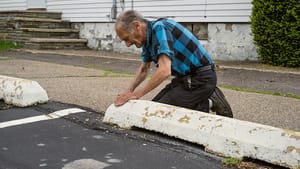Stay in the Loop
BSR publishes on a weekly schedule, with an email newsletter every Wednesday and Thursday morning. There’s no paywall, and subscribing is always free.
Left behind
Philadelphia Photo Arts Center presents 'Justin Kimball: Elegy'

Justin Kimball spent years photographing areas that would become Trump country. A handful of images from the photographer’s journeys are on view in Justin Kimball: Elegy, a Philadelphia Photo Arts Center exhibit at the Gershman Y’s Open Lens Gallery. These small, often one-industry towns across Massachusetts, New York, Ohio, and Pennsylvania appear worn down by globalization, technical transformation, and deep economic recession.
Though few in number, the photographs are evocative and richly detailed. No titles or locations are posted with the large prints, which forces viewers to focus more closely, gathering information from what Kimball reveals through his lens.
If they could talk
Just four of the 11 photos include people, and you’d love to pose questions. Why is the thin, elderly man kneeling, resting his laborer’s hands on a concrete parking barrier in “Wyoming Avenue” (2014)? He’s neatly dressed: short-sleeved shirt and trousers with white socks and heavy-soled shoes. Has he lost something? Did he fall? What drove him to his knees?
See the woman standing, head back, eyes closed, on “Woodland Street” (2015), in a modest residential neighborhood. She appears to have stepped out for a breath of air, a moment of peace. But it’s winter: patches of snow dot the ground, and she’s wearing a sheepskin jacket and knit gloves. You feel the freezing air entering her lungs. What has sent her into the cold, seeking relief?
On “Shamokin Street” (2015), a woman holds a well-fed blond baby on her lap. They wear summer clothes and sit on a porch. On the railing before them, laundry dries on hangers. Are they mother and child? Who wears the clothes on the balustrade? Are they alone in the world? And will the baby ever leave Shamokin Street?

Scenes reward long looks
“Lincoln Avenue” (2012) shows an absorbing tapestry of destruction and rebirth in what appears to be a back alley. It’s spring: tiny emeralds of leaves bubble along branches. Paint peels in a rhythmic zigzag. A ghost shadow runs across a wall, hinting at shelves. A corner of a freshly painted building glows mint green. The view is obscured by a tall fence of fresh, butterscotch-colored wood, which itself will soon be obscured by a tangle of vegetation.
“Liberty Street” (2012) crystallizes Kimball’s perspective. It shows a rippling wall of partially melted siding. The eye drifts down to spy a line of half-singed arbor vitae. Below that and closer, a broken beam, the corner of a mattress. Suddenly the picture snaps into focus: we stand where a fire consumed a home, leaving behind the collateral damage. It’s a poignant metaphor for once-thriving places incinerated by change; it swept through too fast to fight, and survivors were left with the ruins.
Still waiting
The struggle Kimball depicts is the same dynamic Billy Joel recorded in “Allentown,” a 1982 song about the collapse of the U.S. steel industry. The song angered residents of the Pennsylvania town, who thought they were being mocked. But like Kimball’s photographs, it expressed compassion for the plight of people at the mercy of forces and decisions beyond their control.
Industries convulse, factories shutter, businesses leave, jobs and services disappear, but workers with families, mortgages, and community ties have fewer choices. So they struggle on. It happened 36 years ago, and it is happening still.
What, When, Where
Justin Kimball: Elegy. By Justin Kimball. Through March 24, 2018, at the Gershman Y's Open Lens Gallery, 401 S. Broad Street, Philadelphia. (215) 545-4400 or gershmany.org.
Sign up for our newsletter
All of the week's new articles, all in one place. Sign up for the free weekly BSR newsletters, and don't miss a conversation.